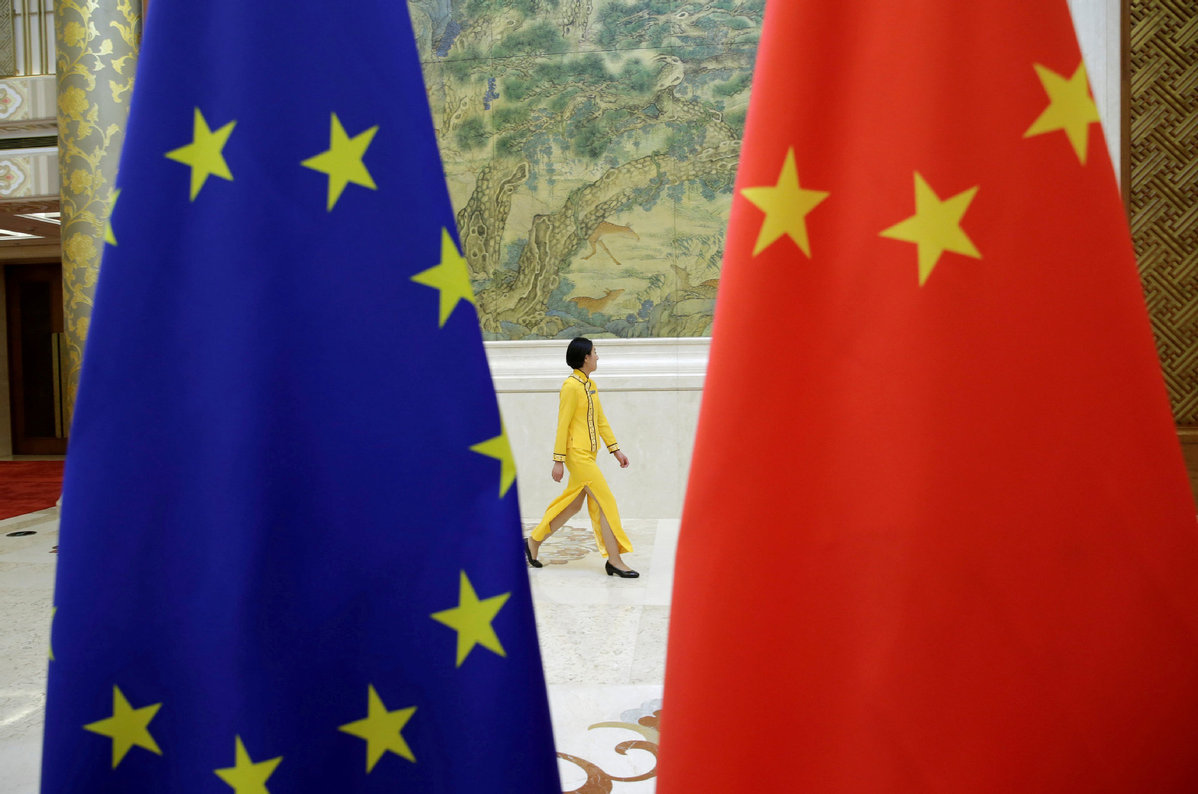
An attendant walks past EU and China flags ahead of the EU-China High-level Economic Dialogue at Diaoyutai State Guesthouse in Beijing, on June 25, 2018. (Photo: Agencies)
China-EU cooperation in combating climate change has a profound history. Being formalized in 2005, the cooperation mechanism has been strengthened several times. For example, climate change figured on the agendas of the talks between the European Union and China in July and September, the last being organized by German Chancellor Angela Merkel, where the two sides agreed to hold "High-level Environment and Climate Dialogue" to pursue joint commitments in the fight against global warming.
China and the EU have already set their respective carbon neutrality targets. The Chinese leadership has reiterated at the ongoing two sessions that the country will achieve carbon neutrality before 2060. On the other hand, the EU, thanks to its Green Deal program, will realize carbon neutrality before 2050.
Both sides have also fixed their interim climate goals. While China has pledged that its emissions will peak before 2030, the EU has taken measures to reduce carbon dioxide emissions by 60 percent compared to 1990 levels by 2030. Since these are ambitious goals, China and the EU should further deepen climate cooperation.
The EU welcomes climate-related commitments in China's 14th Five-Year Plan (2021-25), such as lowering emissions per unit of GDP by 18 percent, reducing the use of coal and increasing the use of renewables, and investing in clean, green technologies.
"We are in a hurry to do things now because the things we do now will dictate what we do in 30 years," said Mauro Petriccione, director-general for Climate Action at the European Commission. "The investment in industry, in energy, in systems, new business models, has to take place now, not in 10 years. Ten years is too late."
China-EU cooperation, too, requires more investment to better combat climate change.
First, China is a big carbon emitter, but also the biggest energy financier and largest market. And to achieve carbon neutrality, China requires huge investments. By some estimates, China will need to spend $5.5 trillion to reach the carbon neutrality goal. As for the EU, it plans to spend €1 trillion ($1.18 trillion) by 2030. But much more needs to be done-for instance, China and the EU could launch a global initiative on green and sustainable finance and invite other parties to join it.
Second, China is undergoing a green technological transition. It already leads in e-cars and is a major force in solar and wind energy. And while the EU has been a leader in innovation, China, in the past, had been playing catch up. But with increasing investment in research and development (2.2 percent of GDP), the same as the EU's and just a shade less that the United States' (2.8 percent of GDP), this can change. In this respect, clean-tech is a growth market with huge potential for China-EU cooperation.
Third, China and the EU could work together to establish a global platform to address the socioeconomic effects of climate change, in order to align climate change mitigation with economic growth, employment and social welfare. According to Frans Timmermans, executive vice-president of the European Commission and responsible for the Green Deal, the green transition should be just and inclusive.
Similarly, President Xi Jinping laid emphasis on ecological transition with Chinese characteristics, meaning it should be fair and just.
Fourth, the market of critical raw materials, which high-tech and green industries require, needs better cooperation. The EU imports about 60 percent of its critical raw materials from China. The Joint Research Centre of the European Commission estimates that between 2020 and 2050 the demand for these materials will double, while the demand for wind turbines and e-car production could increase by 15 times.
Fifth, China has become an important driver of national energy transition in EU member states such as Greece, Spain and Italy. And the wrapping up of the negotiations on the China-EU Comprehensive Agreement on Investment and the need for green investment in the post-COVID era could further strengthen climate cooperation between China and the EU states.
Besides, China and the EU are already cooperating in carbon trading markets, emission trading, carbon pricing, and carbon border adjustment mechanisms.
But will the US' role affect China-EU climate cooperation?
On April 22, US President Joe Biden is expected to host a "Leaders' Climate Summit on Earth Day". Will it change the dynamics? Not necessarily. As Sören Amelang of the Clean Energy Wire recently said: "While the new US administration strives for climate leadership, relations between the EU and China remain key in global efforts to cut emissions."


